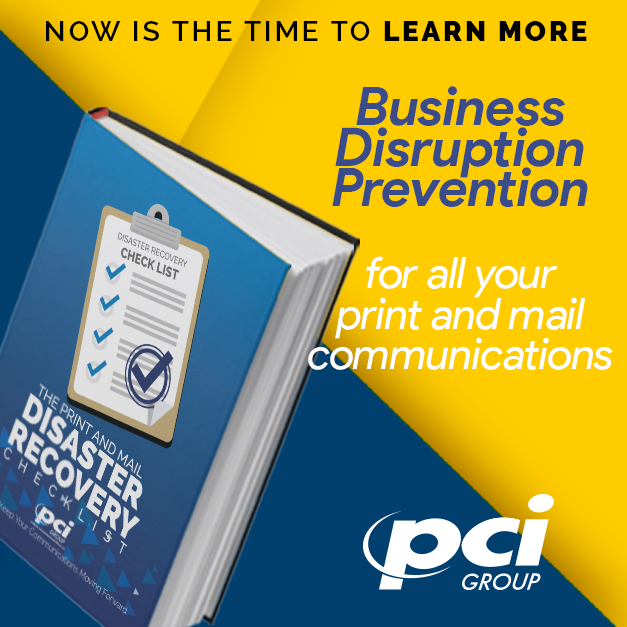
Business continuity and disaster recovery keep your organization running in the face of serious events. While you probably have a plan, how sure are you that it covers everything? Because one-third of businesses with one in place were still unprepared when a response was needed. Plans are great, but the modern business continuity plan should be detailed, relevant, and take into account any process that could be impacted, including customer communications.
Customer communications, of the print and mailed variety, might not have a sufficient strategy to continue after downtime strikes. As a C-suite leader, this is an area of your protocol that should be of special interest. Why? Because in this situation you’re dealing with compliance concerns, regulatory adherence, and ensuring that there’s no delayed response by customers, especially in submitting monthly payments. So, here’s a quick review of what you need to know.
Backups Aren’t Sufficient for Customer Communication Data
Of course, all your data needs to always be backed up, but counting on this tactic to work in customer communication business continuity, isn’t a safe bet. If you are simply backing up the latest batches of letters to a remote source, this doesn’t ensure that the files get printed. In this case, you’re dealing with letters that must be printed and mailed, not digital communications. What does your plan say about how to get this data to your business continuity vendor or another site controlled internally?
The better approach is to work with a partner that always has your latest data sets. A third-party provider is uniquely prepared for your plan if they are already supplying this to you on a regular basis. If you still believe keeping your in-plant in place is a good business decision, still work with an experienced provider on business continuity efforts. Keep them updated with any changes by sending them new data regularly. This way they have your current template and can have you back to printing in an instant.
Customer Communication Workflows Are No Longer Manual
Years ago, a plan may have been rudimentary for this channel. If manual processes were involved, they continued. Not so in the 21st century; the sheer volume has necessitated automation. That’s why this area of your plan can’t be forgotten. No assumptions should be made about the company’s ability to continue these without tools. Take this risk off your plate by partnering with a provider that has the necessary equipment and technology to get back to automation with no increased costs.
You Need Experts for Every Area of Your Business Continuity Plan
A wide variety of systems require attention in your plan. The sophisticated infrastructure and architecture of your business cause the need to have experts in their areas as an extension of your company’s continuity efforts. There’s all your digital data, physical spaces, and other tasks. These tasks keep the business running. And while much of this is online transactions, there’s still a need for engaging a partner for printed communications. This isn’t’ something you can leave up to chance or assign to other vendors that don’t have the expertise. They most likely won’t understand the compliance and regulatory requirements nor have sufficient equipment.
Your In-House Team Should be Accountable
If you have an internal in-plant for printed customer communications, then this team needs to assume the responsibility in business continuity. They should have a complete assessment, working with a vendor that’s been vetted and tested. It will be their job to negotiate service-level agreements as well as ensuring the third party has the most accurate information. If this is a group you oversee, it’s time to ask some questions about their continuity response.
Be Aware of Any Other Risks and Threats
Any data sets that have personal or proprietary information must be safe and secure. In considering printed customer communications, there are risks and threats that might not be glaringly obvious.
Here’s a quick checklist:
- What is the physical security of your in-plant in a disaster situation? Could the space be breached, and information stolen?
- Will any new communications printed and mailed by the vendor be traceable? This benefit comes in handy when you’re reconciling communications post-event.
- Are you being overcharged by your vendor in your time of need? Depending on contract, your company may be facing huge costs outside of the monthly fee you pay when it’s time to initiate a recovery plan. This kind of thing is common. Think of it like property insurance. Once you file the claim, you’re on the hook for a deductible and your monthly premium could go up. Check your agreement to see if any of these fine print fees exist.
Learn More with the Disaster Recovery Checklist
Business continuity and disaster recovery plans aren’t something you ever want to have to use, but the fact is that many organizations have to enact at least some part of their plan. Modern business deserves a modern plan. With all the critical processes that need to be restored, your plan should address every part of how you operate, including customer communications. Now that you know, learn more by downloading our Disaster Recovery Checklist.


